Soviet Ghosts Vacation in Santiago
An émigré travels in Chile with his wife and daughters
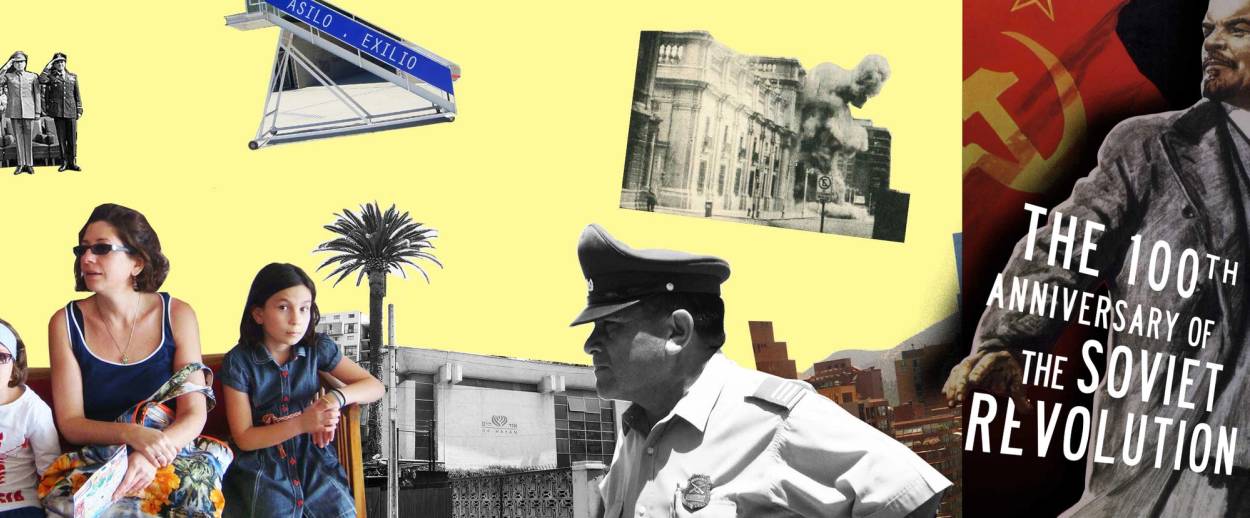
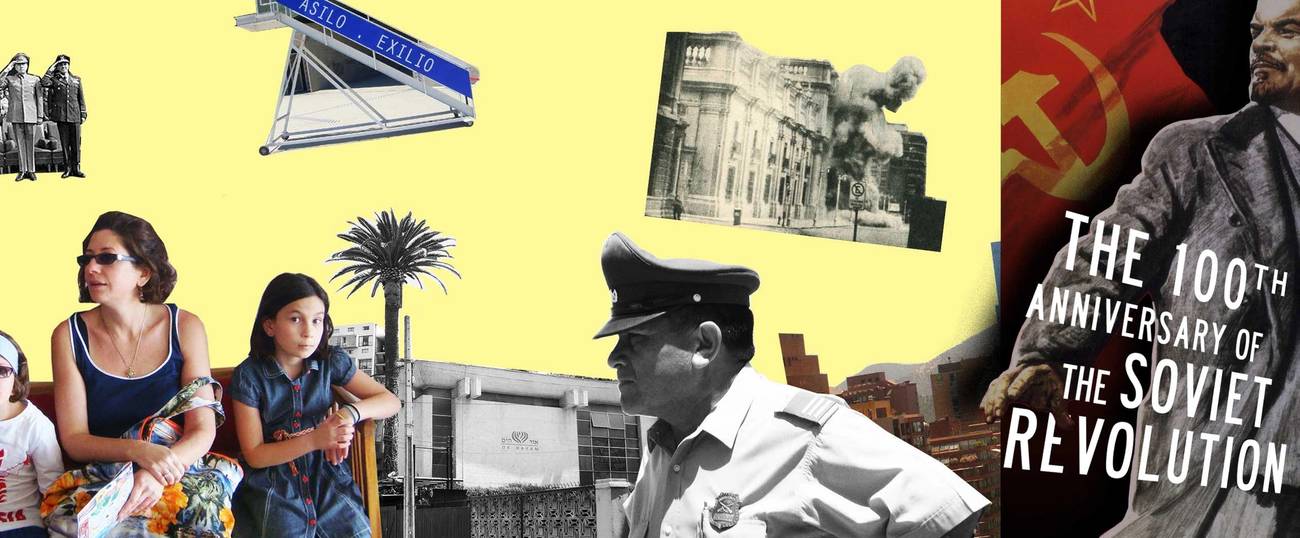


Flight to Santiago
“What is junta?” asked Tatiana, our 7-year-old daughter.
It was Christmas day; we were waiting to board a flight to Santiago. Next to us, slumped over in his seat, sat an American businessman with rows of numbers on his laptop screen. He told us he was in the commodities business, had been living in Santiago since the early 2000s. “The country is kinda messed up, very nice agricultural produce, great outdoors,” was the American expatriate’s take.
“Junta,” explained Karen, my American-born wife, “is when bad people took over Chile, overthrew the president and ruled it like a police state. They killed and tortured people.”
“And their leader’s name was General Pinochet,” I added, matter-of-factly, pronouncing the ch as in “chess” and -et as in “pet.”
The American copper baron got up, a sneer on his broad face, and moved closer to the check-in counter.
We were at the Atlanta airport, the girls and Karen had been reading Who Was Martin Luther King Jr.?
Then Mira, our 9-year-old daughter, asked: “Do we have any relatives in Chile?”
“No,” I answered. “Only in Venezuela and Peru. Cousins on mama’s side who moved to Peru from Colombia.”
“And on your side?” Mira asked.
“Distant relatives in Venezuela,” I replied.
“Papa, I have a question,” said Tatiana, the family’s designated asker. “Were you still in Moscow when the bad stuff happened in Chile?”
“When the coup happened? When the junta took over?”
“Yes,” Tatiana confirmed.
“It was in 1973, I was definitely still in Moscow,” I answered in Russian.
“Were you in kindergarten?” Mira asked.
“Very much so, and we weren’t even refuseniks yet.”
A current of memories picked me up and carried me back to my Soviet childhood, and I swam in this current for the next hour until they announced the pre-boarding for families with children.
I remember quite a bit of my life from the autumn of 1973. I was 6 years old, my father had taken me to Sochi on the Black Sea, and at kindergarten, I was discovering the loneliness of a Jewish boy. We were living in a leafy (though ecologically dangerous) Moscow neighborhood near the Institute of Atomic Energy, and most of my classmates’ parents came from the ranks of academics, technocrats, and upper-tier military officers. Of the coup in Santiago—that other Sept. 11—I recollect a vague something in the air, the words khunta and perevorot (“coup,” literally “overturn”) rolling off the grownups’ tongues like ribbed hand grenades. My most vivid memory from the autumn of the Chilean coup is that of a dinner party at the apartment of my late maternal grandparents near Dynamo soccer stadium. My bon-vivant grandfather Arkady (Aron) had taken his sons-in-law to his den, where they sat on a leather divan, ate elongated Crimean grapes ripened with gold, drank cognac, and talked politics. The only child at that family gathering, I stood by the door half-closed onto the world of men and politics, listening in as my father, a poet-doctor, talked about Franco and the Spanish Civil War. Thirstily I snatched up echoes of those powerful words: junta, dictator, overthrow, regime, solidarity, diplomatic relations broken. Words used with the understanding that they meant something—sometimes more and sometimes less—in the context of our Soviet living.
Chile—and anti-junta propaganda—was a piece of my childhood and youth. I suppose one might correct me that it wasn’t just Chile but most of Latin and South America, one of the main playgrounds for the Soviet international game of influence; a political gambit that started with Cuba. But Chile bears a special significance for the generation of Soviets born in the 1960s and 1970s. By the time I was entering middle school, in 1976-77, Cuba and the rhetoric of solidarity with the “island of freedom” was getting stuck on our teeth. The long-bearded, cigar-smoking Fidel had become too much of a bogeyman in the daily murals of Soviet political education, and I had trouble mustering genuine feelings for the Cuban revolution. Chile was different, at least for me. The 1973 coup against the Allende government of Unidad Popular, resulting in General Pinochet’s lasting dictatorship, was being portrayed as a Cold War reincarnation of General Franco’s onslaught on the Spanish Republican government. The Spanish Civil War, that first war against fascism, had been one of the principal political myths for the Soviet generation of our grandparents, and its legacy continued to hold captive both their children and grandchildren in the 1970s.
I remember the arrival of Lois Córvalan in Moscow following his release from a Chilean prison in the remote Tierra del Fuego—photographs of the Chilean Communist leader with mouth-gaping Brezhnev, battalions of waving Soviet children; the chanting of ¡No Pasarán! at the school rallies. And I also remember the chernukhi (black-humor ditties) inspired by Córvalan’s return, which we recited in backyards and at school recess: “It’s quiet in the woods/ Only the ram’s awake/ Luis Córvalan is free again/ That’s why the ram’s awake.” (In the original Russian, “Córvalan” end-rhymes with baran, literally “ram” but figuratively “dumbwit.”)
Why did the Soviet popular imagination create these ambivalent ditties? In high school or already at university in the early 1980s, I would learn that the freedom of Córvalan had been brokered in exchange for the release of the imprisoned Soviet dissident Vladimir Bukovsky. I would also later discover the rueful comment alleged to the famous Soviet author Viktor Nekrasov, author of In the Trenches of Stalingrad, who by 1976 had run afoul of the Soviet authorities and was living as an émigré in Paris: “Now, to restore complete order, we need to trade Brezhnev for Pinochet.” This comment was picked up and cloned by Soviet underground satirists. In retrospect (and retrospect doesn’t work well in reconstructing the ideological vagaries of a Soviet youth) I can see how Soviet boys and girls would recite absurdist lines about the leader of Chilean Communists and also revile Pinochet and his henchmen.
A jumble of “Chilean” memories—celluloid, musical, literary. … I remember myself in Young Pioneer summer camp, June 1977, standing at an all-camp rally and chanting the words “Bella ciao, ciao, ciao” along with a wheezy loudspeaker, from which streamed the spectral voice of Víctor Jara, the murdered Chilean bard and radical, whose name was well known in the USSR. “Bella Ciao” wasn’t Jara’s own composition but his rendition of an Italian partisan song from the time of World War II. And another summer-camp flashback: a screening of a film about Chile, which had come off the same conveyor belt as most Soviet films about revolutionary unrest. Meant to inspire, the formulaic film left no trace except for one scene in which Chilean workers with old rifles defend a barricade from a unit of tanks.
However, one film must have made such a strong impression that it was still with me as I prepared to travel to Chile. It was called Centaurs, and I saw it with my father in the autumn of 1978. I was 11, and we were literally on the brink of applying for exit visas and getting stuck for almost nine years—my formative years. I distinctly remember that it was a boys’ outing—this sort of film wasn’t my mother’s cup of tea, and my father and I saw it in Vostok (Orient), our small neighborhood movie theater located in Moscow’s Kurchatov Square. The entrance to the movie theater was opposite a small public garden, catty-corner from the giant bearded bronze head of Academician Igor Kurchatov, whose group developed the first Soviet atom bomb. Beyond Kurchatov’s head, placed atop a black granite pedestal, was the campus of the Institute of Atomic Energy, where half the residents of our apartment building were employed. The movie portrayed a military coup in a fictitious South American country with a Socialist president who abhorred violence, and, like Allende himself, was trained a medical doctor. He was played by Donatas Banionis, a brilliant Lithuanian actor with a guilty, compassionate smile, who has the lead part in Tarkovsky’s Solaris. The insurrectionist leader, a reptile that never shed his dark glasses, was suggestively named General Pin.
Something about the film resonated with me and, I could tell, also with my father, as we stood with one foot in refuseniks’ limbo. Thirty-seven years later I was curious to see the film again. In researching it, I discovered that it was a joint Soviet-Hungarian-Czech-Colombian production, directed by the Lithuanian Vytautas Žalakevičius and shot by Pavel Lebeshev, one of the most celebrated Soviet cinematographers, known for his dislike of artificial lighting. I watched Centaurs again as I prepared to write about traveling in and explaining Chile to my daughters. The conversations of the South American intelligentsia depicted in the film reminded me of members of the Soviet intelligentsia arguing about divided loyalties. What is one supposed to do when her own country points a gun to her temple?
And one more double recollection, this one from my sophomore year at Moscow University. It’s September of 1985. About 300 of us are gathered in an amphitheater-like auditorium with dark-wood paneling and portraits of the stern bearded fathers of Russian natural sciences. A Komsomol activist with a wheaten mustache à la russe announces a commemoration of the 1973 coup “against Chilean workers and peasants” and introduces the main speaker. A suave man in a foreign-cut pinstripe suit comes to the podium. He speaks in a mellifluous baritone, delivering perfect Russian sentences laden with archaic expressions. This is professor Boris Rozanov, the dean of Soviet ecologists and a grandee of the academic establishment. He tells us a story of visiting Santiago some time in the late 1970s, during his tenure at the United Nations Environment Program. Rozanov described being in Chile on official business and running into a fellow Soviet, a trade representative. The way he told the story, the two of them were happy to run into each other and “did some eating and drinking together.” Then they started singing revolutionary songs in a hotel room. “And imagine,” Rozanov spread his arms, addressing an audience of students born in the middle 1960s. “The hotel administration became so alarmed that they called the police. They couldn’t touch us, but they were scared by our revolutionary spirit.”
Whether embellished or not, the story touched no chords in me. It felt like fullproof Soviet propaganda, even though there might have been truth about Chile in the professor’s account. And by coincidence, as though destiny was testing me to see how much I had shed of my childhood romantic illusions, only days after that Chile commemoration, my Moscow friend Maxim Mussel and I chanced upon a screening of It’s Raining in Santiago, a 1975 French-Bulgarian film featuring the French actors Jean-Louis Trintignan and Annie Girardot, both of them fabulously well known in the Soviet Union, and a score by the Argentinian composer Astor Piazzola. This kind of film we would see to catch a glimpse of life in the capitalist West, and there was just a bit of that in fancy Santiago hotels and in airplanes, but mostly Chilean life looked like poverty and Soviet drabness. In the ending, set in a large stadium in Santiago, members of Pinochet’s military terrorize hundreds of men and women detained during the coup. A commanding major, clad in a greatcoat and a low-slung helmet and made to look like a Nazi officer, orders the deadly beating of a revolutionary singer.
Growing up a refusenik had made an anti-Soviet out of me, but it didn’t rule out sympathy with victims of a foreign fascist dictatorship, a dictatorship that wanted to root out the prospect of a Communist totalitarian system not unlike the one we opposed in the Soviet Union. The Jewish-Russian boy I once was still had a soft spot for Chile. But how to explain all this to my American daughters?
The time has come to explain why we were going to Chile in the first place. On the broad surface of it, it was a compromise. A compromise between wanting warm-weather for a winter getaway (me) and desiring a Latin cultural experience (my wife). The kids would have taken Aruba, where we had previously gone in December-January. Karen had inherited a special connection to the Spanish language and Latin and South America from her late father. Born in Czernowitz, Bukovina, Karen’s father and his parents lived through the hell of Transnistrian camps, and after the war, they ended up in Bogota, Colombia. Karen’s father grew up with Spanish as his main language and spoke it like a native; he left Bogota for Boston in 1960, never to set foot in South America again.
Chile was also supposed to be a good place to expose children to latitudinal climate diversity and zonal transformations in nature. Even though I still wasn’t sure what there was for me to research and to write about, we booked a two-week trip for late December and early January. “You can write a short story about our trip,” Karen said to me. Imagine a place where children of Holocaust-survivors and of escaped Nazis were living side by side and going to the same schools…
Our itinerary was chosen in consultation with two Chileans. The first was the rabbi at our shul in Brookline, who was born and grew up in Santiago and immigrated to America as a young woman in 1971, following Allende’s ascent to power. The rabbi’s mother had left Nazi Germany in 1939 and wasn’t inclined to stay and wait for what the future might bring. The rabbi’s father, a Russian Jew, had grown up in Shanghai and emigrated from China to Chile after the Communist takeover; he spoke a beautiful, slightly antiquated Russian, and the prospect of encountering descendants of Russian Jews in Chile ignited my imagination. The other person we interviewed was a Chilean psychologist married to an ex-Soviet Jew who had been my aunt’s university classmate back in Moscow. Both Chilean women independently recommended that while in Santiago we stay in Las Condes, an upper-middle-class area of the city. “Stay at an American hotel,” the ex-Chilean psychologist recommended. The psychologist wanted to send us by car from Santiago to Puerto Montt, with the idea that we would drive slowly and explore parts of Chile, especially the towns founded by German immigrants in the 19th century. After that, she recommended that we take a boat to exotic locations in the south of this very long narrow country. The rabbi gave us recommendations based on where she went with her family while growing up in Chile in the 1960s: the lake and volcano district in Araucanía, and the resort of Viña del Mar on the Pacific coast. Can you guess which recommendations we trusted?
So there we were, on Christmas Day in 2014, getting on an overnight flight to Santiago. As usual, I had trouble falling asleep on the plane. Karen was asleep, the girls were enjoying the freedom of unlimited TV, and I was sipping bad airplane cognac, sifting sands of Chile-related information through my head. Before dozing off I revisited a recent conversation with a mathematician who worked at my university. We had bumped into each other on campus, and when he heard that I was going to Chile, he said to me: “For some reason, I vaguely recall that a Russian mathematician had disappeared in Chile. I believe it was some time in the late 1980s.” It only took a few attempts at plumbing Google to discover that Boris Weisfeiler, a Jewish mathematician who had emigrated to the United States from Russia, disappeared in Chile in 1984 while hiking in the Andes. He was never found, and his disappearance has been linked to Colonia Dignidad, an outpost run by former Nazis in central Chile.
Museum of Human Wrongs
I’m a believer in the tried-and-true method of gleaning the essence of a new country by observing the road from the airport. Driving from the airport to Rio de Janeiro, one passes over a number of favelas—shantytowns—that hit the traveler with that remarkably Brazilian mixture of poverty, splendor, and vivacity. Beehives of corrugated roofs and unfinished dwellings may be shocking or disturbing to the visitor’s senses, but I’ve never found Brazilian urban landscapes depressing. With Santiago, it was different. As we approached the city outskirts I caught my first glimpses of the city of Santiago, lying like a pile of smoking corpses on the palms of the snow-capped mountains. Traversing the city from the west, we entered a Technicolor world of aridness and apathy, of feeble gardens and downward-gazing homes. The banks of Río Mapocho, which flows through Santiago, cutting it in two, were dry, dirty, and free of vegetation; the river itself resembled an open sewer.
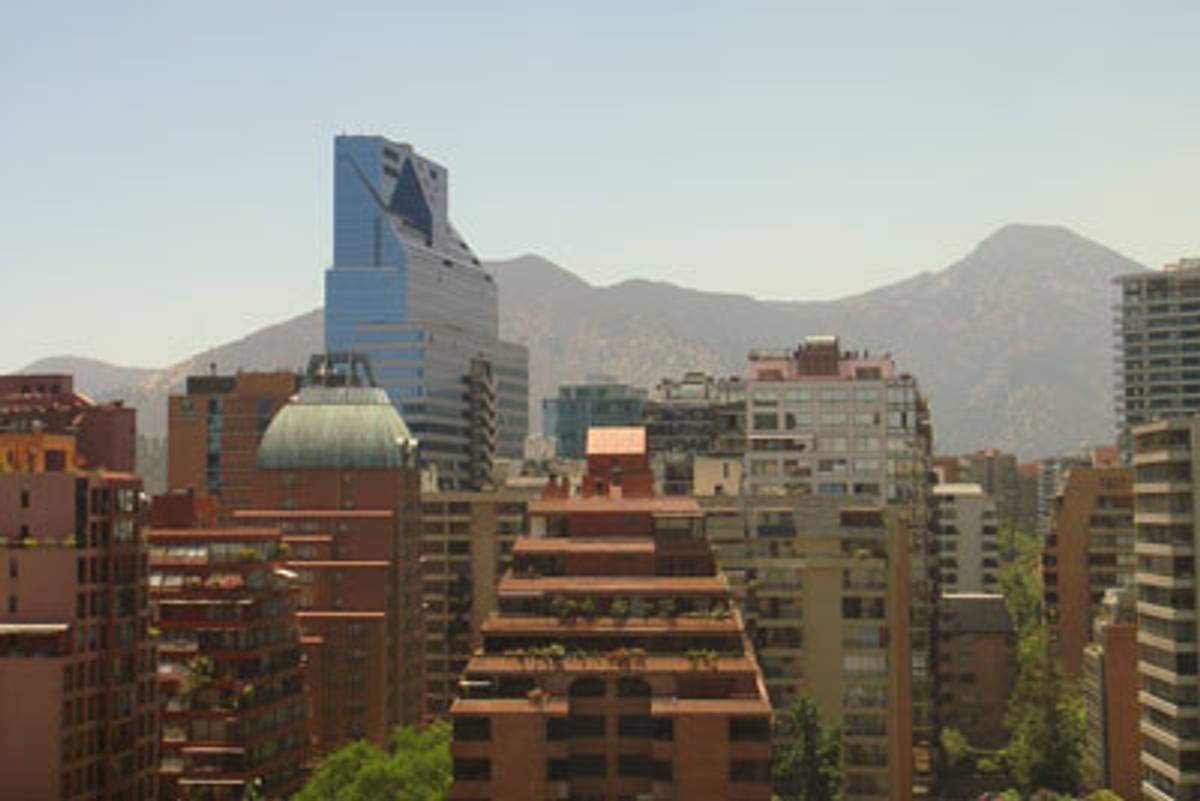
Upon our rabbi’s advice, we had booked a hotel in Las Condes, a more-affluent area in the eastern section of Santiago. I was amused to find out that Michelle Bachelet, the current Chilean president, makes her home in Las Condes, as previously did both President Salvador Allende and Gen. Augusto Pinochet, the man who overthrew him in 1973. Signs of Jewish communal life were present here and there in the neighborhood, most notably in the Estadio Israelita Maccabi, a sports complex located east of our hotel on Avenida Las Condes. Our cab driver referred to the neighborhood just west of our hotel as “Sanhattan,” and he was speaking with tired pride. From the windows of our comfortable hotel, I saw majestic mountains girding the perimeter of the city. The mountains’ cinnamon-colored bodies and white caps were printed on the walls of the skyscrapers and reflected in the mirrors of our suite; mountains rode on the roofs of vehicles and entered parking garages. In the purity of their natural forms, the Andes were silent witnesses to the Chilean capital’s scrambled past.
I kept a journal while in Chile, and I turn to it for raw impressions of what struck me during those three days in Santiago. There were lines in pharmacies. No, not because there were shortages of medications, but due to dysfunctional service—a kind of Chilean Sovietness, if I had to put my finger on it. You waited in one line to request a product, then in another line to pay for it, and sometimes in a third line to pick it up. I don’t know whether this was done to overemploy people or to foster a bureaucratic orderliness, but for an American of Soviet origin, the results were exasperating. At entrances to funiculars, at museums, even at supermarkets we encountered the same lethargy of workers and the same silence in response to complaints. My impression was that in Chile a failed Marxist socioeconomic experiment followed by years of right-wing junta had resulted in a lack of interest in work coupled with a morbid public vigilance. There was no rudeness, just silence. Silence and what felt like an aggravated police presence in the city streets.
Our goals for Santiago, other than getting acclimatized and giving the girls enough time to frolic in the rooftop pool, were to see Pablo Neruda’s house and two major museums, the Museum of Pre-Columbian Art and the Museum of Memory and Human Rights. We came to La Chascona, Neruda’s house-museum, after a stop at the Santiago Zoo, a ride on the funicular up to San Cristóbal Hill (where unsmiling carabineros filtered the crowd), and lunch at La Percanta, an elegant little place in the bohemian Bellavista neighborhood. Karen and I were drawn to Neruda’s life and legacy, but for different reasons. Karen had read Neruda’s ardent love poems in the original Spanish—a link with her late father’s South American youth.
Neruda, whom I had originally discovered in excellent Russian translations and subsequently read in English and tasted in Spanish, wasn’t the poet I would carry with me to exile. But the shape of Neruda’s career preoccupied me as did the careers of other left-wing artists and writers of the generation and a half born in the 1880s-early 1900s, among them Picasso, Aragon, Hikmet, and Rivera, who opposed dictatorships and fascism at home while also serving, unwittingly or not, as apologists for Stalinism. In reality, it was always more complicated than either/or, and apologism assumed various shapes, from demonstrative wartime support of a country bleeding itself to defeat Hitler’s hordes to turning a blind eye to Stalin’s own crimes. Shadows of the Spanish Civil War—García Lorca’s martyred shadows—darkly illuminated Neruda’s path as it inspired him to write of love and death. Stalin’s murderous smirk, emblazoned on red banners of the oppressed and downtrodden, compromised the poet’s political allegiances. That Neruda, a Chilean senator, joined the Communist Party in 1945, the year Nazism was defeated, is hardly beguiling. Nor is it particularly surprising that Neruda would later speak, with a gently ironic smile on his puckering lips, of having added another poetic voice to Stalin’s personality cult. Try reading his wooden ode on Stalin’s death today; it’s a monument to historical blindness. “The bard of Chile’s workers and peasants never publicly criticized the Soviet Union,” I said to my wife as we toured La Chascona. “But he loved the comforts of bourgeois living.”
La Chascona was the house Neruda had started building in 1953 for Matilde Urrutia, then his secret love and later his wife. One of Neruda’s three Chilean houses, this cascade of rooms and additions sits on a mountain slope atop what used to be a gully traversed by a creek. Fellow artists used to bring Neruda, a passionate collector, pieces of their homelands when they visited, and several Russian and Soviet vestiges were displayed in Neruda’s rooms. My daughters immediately noticed matreshki, the nesting dolls, on one of the shelves.
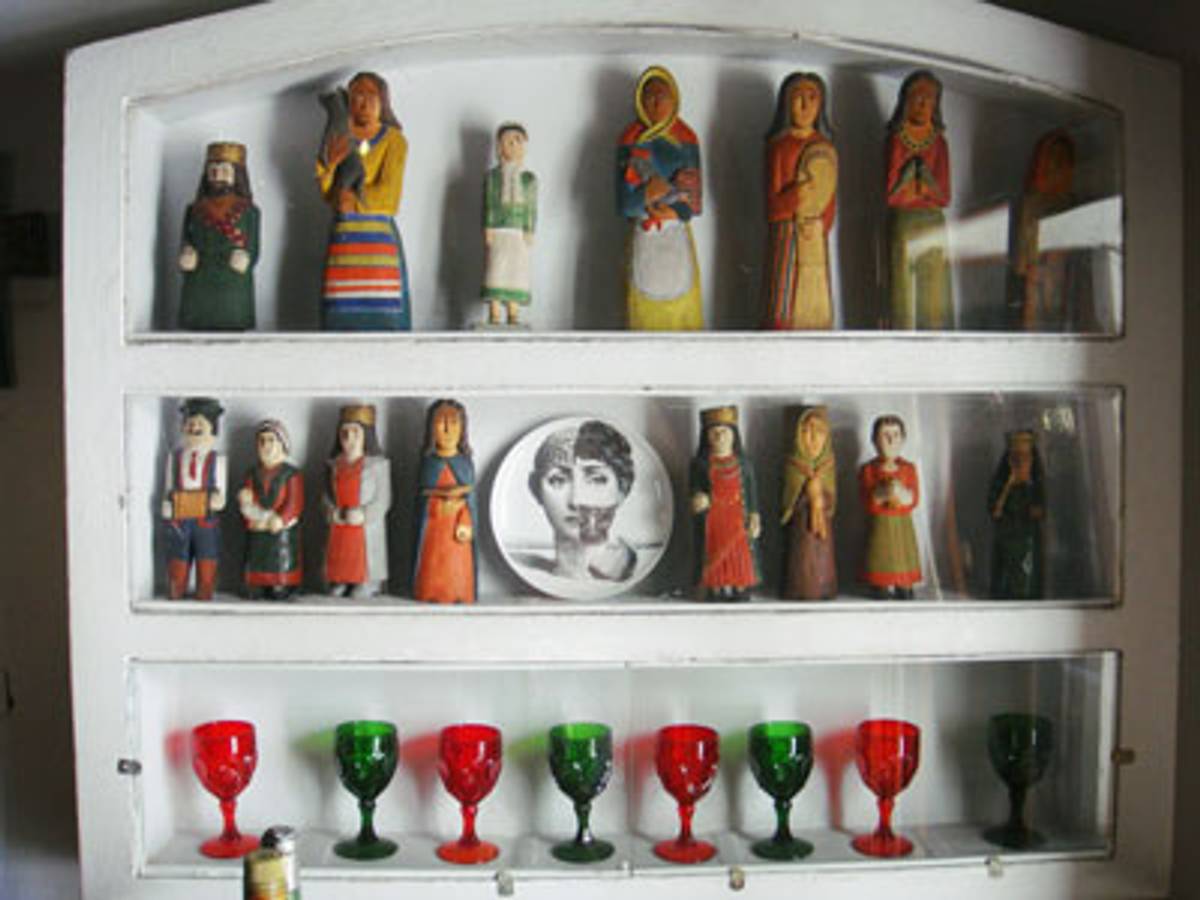
In the poet’s library, displayed in a glass cabinet on a shelf below the 1971 Nobel Prize for Literature, is Neruda’s International Lenin Prize medal, as it’s labeled in the display case. When Neruda was awarded the prize in 1953, it was still called the International Stalin Peace Prize. He received it from the hands of Ilya Ehrenburg, whom he had met and befriended in Madrid in 1936. Poet, novelist, and journalist, one of the principal architects of Soviet anti-Nazi propaganda, co-editor of The Black Book, Ehrenburg’s was Stalin’s postwar cultural envoy to the West. A Russian Jew, a close friend of many left-wing avant-gardists since their shared days in Paris in the 1910s-1920s, Ehrenburg had a special connection to revolutionary artists, among them the Brazilian Jorge Amado, the Cuban Nicolás Guillén, and the Mexicans Diego Rivera and David Siqueiros. In People, Years, Life, one of the Soviet intelligentsia’s open windows onto modernism, Ehrenburg described visiting Neruda in Chile in August 1954: “For a week I became the most popular person in Santiago. Friends advised me to stay close—fascists wanted to beat me up. Yet I would go into town (Neruda’s house is on the outskirts) sometimes with Pablo, sometimes with one of his friends. With Pablo, I visited a working-class quarter. After one hour, the driver, who served as my bodyguard, implored me: ‘If we continue, I’ll have a heart attack…’ Workers recognized me and charged to hug me, and each time the driver became alarmed—what if those were fascists?… It seemed that all of them had lost their heads. Only Pablo remained completely calm, wrote poems, napped after lunch, told amusing stories. He said that, of course, he hadn’t expected such a turn of events, though it was nothing surprising; the Yankees controlled things, acting like they were at home here, but soon this would all end, and then I would be able to visit again, and he would show me Valparaíso and the south of Chile, and I would understand that there isn’t a more wonderful place.”
As Ehrenburg reminisced about Neruda in the 1960s, he called him “fortune’s favorite” and contrasted his lot to that of Vasily Grossman, who, Ehrenburg believed, had been born under an unlucky star. When Ehrenburg wrote about Neruda and the poetry of politics, he was reflecting on his own life as a committed left-wing intellectual and a Soviet Jew: “In this book I have written at such length about tragic destinies of writers and visual artists, that I felt compelled to tell, if briefly and with humor, about a great poet who was a happy man. Of course, Neruda had known hours of despair and disappointment, and much else, which one could never do without, but he never disavowed life, and life never disavowed him. He went against the powerful men of the world, became a Communist, found friends, and, therefore, also found enemies; yet only enemies cursed him, and he never knew what it meant to bear grave offenses from one’s own people. He wrote what he wanted to write about and how he wanted to write about it.” Ehrenburg, who died in 1967, never got to visit South America again or to see the rise of Allende’s government, in which Neruda would become ambassador to France—Chile’s representative to the world.
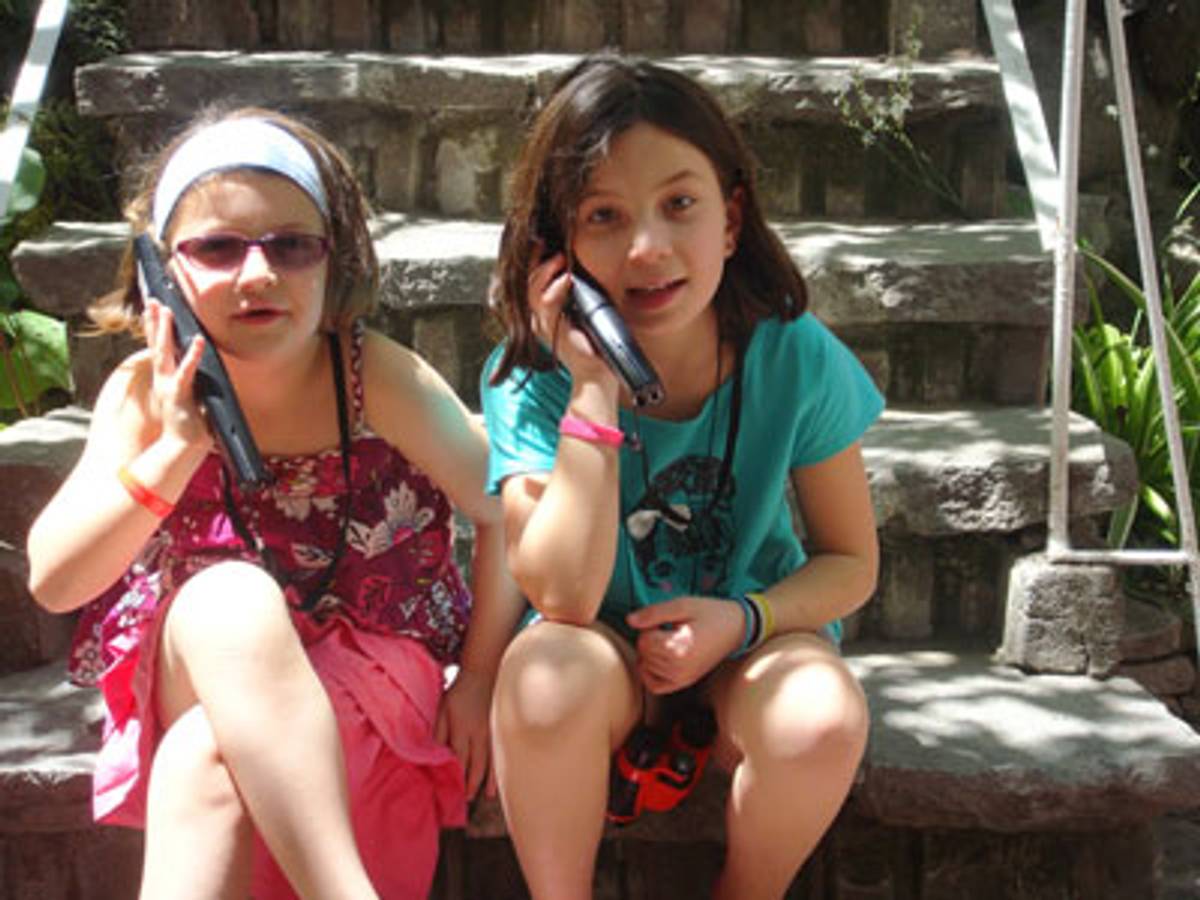
I was so tempted to tell my daughters about Neruda’s ardent leftism, and about his Stalin Peace Prize, but it would have been too much, much too much. Mira and Tatiana sat on the stone steps leading up to the living room of Neruda’s house, adult audio guides pressed to their ears, and Karen and I both realized that they were listening to an account of Neruda’s death. Less than two weeks after the Pinochet coup, Neruda died at Clinica Santa María, which we passed a number of times during our days in Santiago. The story of Neruda’s funeral especially impressed the girls, and they both spoke of the “bad people” blocking the creek at the bottom of the hill, and of the water rising and flooding the first floor of La Chascona during the funeral and wake. The unsimulated indignation with which my daughters spoke of the junta’s messengers who vandalized the dead poet’s home, reminded me of their younger selves coming out of Anne Frank’s house in Amsterdam and saying, very loudly so that the people turned, “I hate the Nazis.”
In retrospect, it was probably unwise to see two museums in a row on our last day in Santiago. The remarkable Museum of Pre-Columbian Art, one of Chile’s crown jewels, is largely a record of destroyed Native American civilizations in Central and South America. The collections are housed in a former palace built in the early 1900s. For reasons not entirely logical, it made me think of two museums, the splendid Pergamon in Berlin but also another, the “Museum of the Extinct Race,” which the Nazis contemplated opening in Prague.
The Museum of Pre-Columbian Art stands about six blocks from the La Moneda Palace, where Allende and his close cohorts died on Sept. 11, 1973. We didn’t go there. There was something unpleasant in the accumulation of police vehicles and troops in the seedy streets adjacent to the museum, in officers resting their hands on the halters and studying us with apprehension. The graffiti on buildings and bollards featured slogans like “Freedom to the Mapuche.”
“Mapuche,” the girls noted, “we saw their clothes at the museum.”
“Yes, we’ll see them soon, in Araucanía, they still have Mapuche villages there,” Karen said to the girls, although we were both wary of ethno-tourism.
The Museum of Memory and Human Rights, a modern complex opened in 2010, commemorates the victims of Pinochet’s junta. It’s surrounded by blocks of abject urban poverty, with boarded-up buildings and graffitied storefronts. Tatiana was too young to see the museum, and we decided to take turns, first Karen touring the museum as I waited with both girls in the cafeteria, then Mira and I taking a tour. I had intended for it to be a selective walk through the museum. I was trying to shield Mira from any parts of the exhibit that deal directly with violence, but it was a futile undertaking. Violence, through numbers, names, photographs, and videos sprang at us from every wall. I saw a reconstruction of an interrogation and torture cell outfitted with an institutional spring bed and a crude voltage machine with two hanging bare wires. For me, the most emotionally draining were video testimonies of Chilean women who described being jailed, questioned, and tortured. They were most shocked by the fact that these “normal,” gentlemanly-looking men of the sort that could be their neighbors, relatives, fathers of their children’s classmates employed torture and sexual violence to break the female captives. The cultured victimizers, a familiar story to those who study genocide and human-rights violations.
As I watched one of the testimonies, Mira waited outside the torture cell, studying photographs at another display.
“Papa, have you heard of Volodia Teitelboim?” she asked me.
“I have, why?” I answered. “Volodia sounds like a Russian name,” Mira said as she pointed to a page of a Spanish-language magazine displayed under a glass.
Volodia Teitelboim was a Chilean Communist writer and activist. After the 1973 coup, he fled to Moscow and ran a Spanish-language radio program broadcasted for South America.
“You’re right,” I told Mira as we walked down the stairs to the museum lobby. “Volodia Teitelboim’s parents were Jewish immigrants from Russia,”
“Why were many Jewish people against Pinochet?” Mira asked.
Once again, the Jewish question had invaded our trip, even though we didn’t seek this particular brush with it.
“Because they fought against injustice,” I answered. “Because Jews were drawn to socialism. They supported the rights of the working people, the poor. Because…”
“But didn’t you say many Jews in South America were rich?” Mira must have overheard me and my wife talking about relatives in Venezuela and Peru who were in the textile business or ran large agricultural estates.
Once again, the Jewish question had invaded our trip, even though we didn’t seek this particular brush with it.
How does an ex-Soviet Jew explain to his 9-year-old American daughter—explain without sounding like a pastiche of the Protocols of the Elders of Zion—the eternal contradictions of being Jewish in the modern world? And how about helping one’s children make sense of the fact that Jews find themselves fighting on opposite sides of the barricades of history? Not unlike Jews in other Latin and South American countries in the same years, Chilean Jews were active in the left-wing movement. Jews, among them Minister of Agriculture Jacques Chonchol, served in the Unidad Popular coalition government and advised Allende on matters ranging from nationalization of copper mines to banking and finance. And for whatever such facts are worth, Allende himself was, on his mother’s side, a descendant of Jewish converts to Catholicism.
Of course, Allende’s government ruled for only three years, and Pinochet stayed in power for 17. But in some ways, more sobering is a catalog of Jews who held positions of prominence under Pinochet, among them Miguel Schweitzer Speisky, who served as Pinochet’s minister of justice from 1975-77 and Chief of the Air Force Staff General José Berdichevsky Scher, who ordered planes to bomb La Moneda during the 1973 coup and was subsequently Chile’s ambassador to Israel. During the years of the junta a number of Pinochet’s key economic advisers, some of them members of the team known as the “Chicago boys,” were Jews.
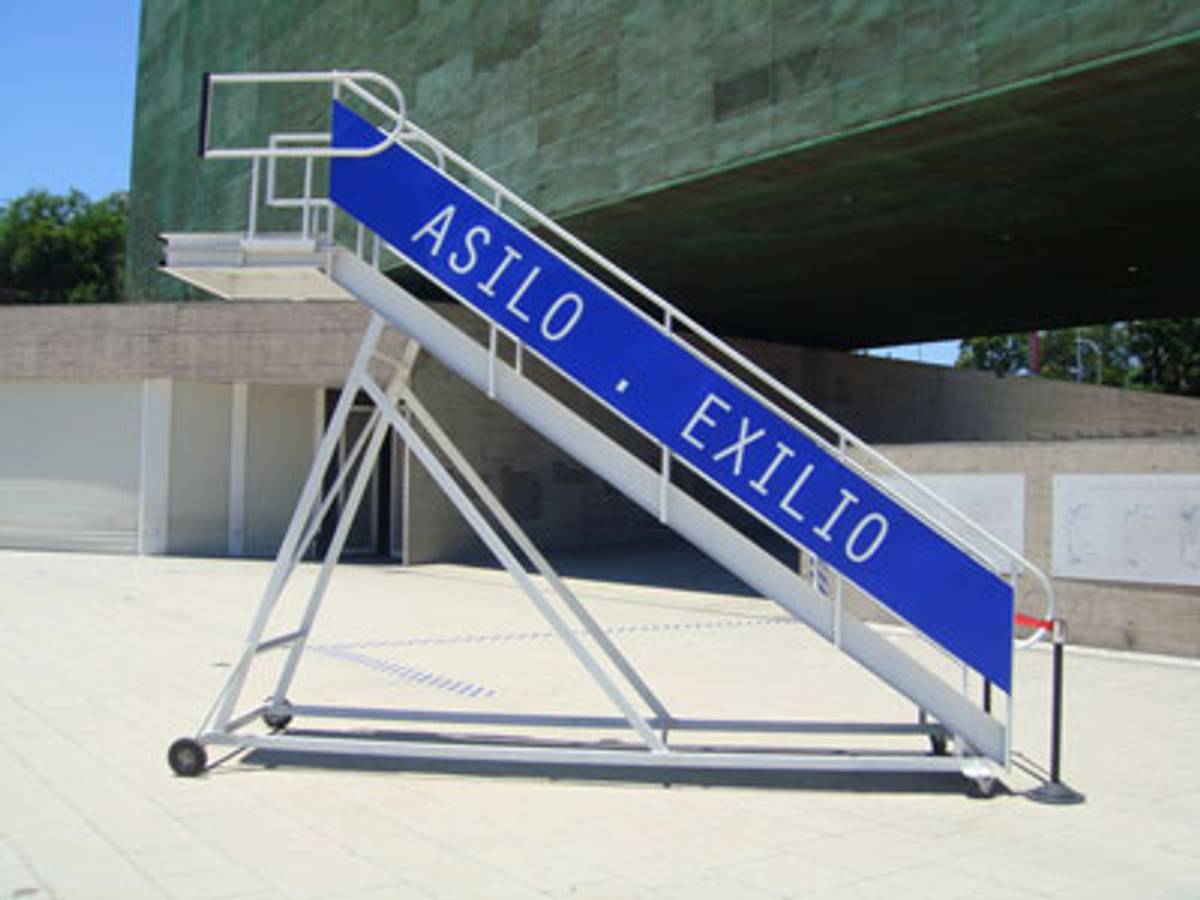
In the courtyard of the Museum of Memory and Human Rights, we posed for a picture against a movable gangway with the words asilo (asylum) and exilio (exile) printed in white on its sky-blue side. This referred to tens of thousands of Chileans who fled the country or went into voluntary exile following the coup. About 10,000 Jews left Chile during the Allende years in the early 1970s. Some of them returned after the coup. Gen. Pinochet and members of his junta made public displays of support for the state of Israel, which fared well with the Chilean Jewish community.
“This is like papa and his parents who left Russia,” said Tatiana, who shares her name with Pushkin’s cherished female character.
“In essence, yes,” I said feebly, and I didn’t have it in me to elaborate on the similarities and differences. I felt physically ill after listening to the victims’ testimonies.
When we got back to the hotel, I was running a fever. Karen took the girls for a stroll and to the supermarket, and I lay alone in our room, my eyes fixated on the snow-covered mountains outside the hotel windows. I had never had such a visceral reaction to a museum of persecution, this after having visited KGB and “occupation” museums in former republics of the Soviet Union, including the one in Vilnius, Lithuania, where one can see a sound-proof interrogation cell more or less the way it was when the local KGB hastily abandoned it in 1991. I was lying in bed and imagining a coup, tanks and armored carriers driving downtown from the barracks on Santiago’s outskirts, and my wife and daughters caught in the street fire. I wanted to escape from Chile and go back to Boston. I remembered Vladimir Nabokov’s poem “The Execution,” in which the émigré poet wakes up from a nightmare of being arrested by Bolsheviks “once again feeling” sheltered by the “beneficent exile.” By the evening my fever had subsided. My wife thought I might have had a psychological reaction to the museum. A paroxysm of persecution?
The Lamb Slaughterers
My meltdown notwithstanding, we forged ahead with our travel plans. At Santiago’s immaculately maintained airport, gentlemen of the older generation, jacketed and cravated, and ladies dressed for a party, perfumed and bejeweled, slowly sipped their coffees and leisurely ate their cakes with tiny spoons. Now in their 70s, I was thinking, these Chilean travelers were in the prime of their careers during Pinochet’s coup. As we boarded, I noticed that the aircraft parked next to us at the gate was a Russian-made Antipov operated by Volga-Dnepr Airlines. What was the likelihood of that happening to an ex-Soviet traveling in Chile?
We were headed for Temuco, the capital of the Araucanía region in the center of the country, the city of Neruda’s childhood. Once a stronghold of the Mapuche, who had withstood both Inca conquest and Spanish conquest, Araucanía was eventually occupied in the second half of the 19th century. Starting with the 1850s, parts of the region were settled by German-speaking immigrants, who were originally escaping after the midcentury European revolutions. A second wave of German-speaking settlers followed in the first third of the 20th century. In the late 1930s, the German-settled towns in Araucanía were a stronghold of Nazi sympathizers in Chile, and I wondered, reading up on the region’s history, how Jewish refugees from Austria and Germany felt after they arrived in Chile and ventured to vacation in Araucanía.
In the end, we decided to forgo Mapuche-focused tourism, heading directly to our destination, the area of Pucón tucked amid lakes and volcanoes. As we drove south and east from Temuco along the south shore of Lake Villarrica in the direction of the Argentinian border, signs of a Germanic influence, diluted and Hispanized, were apparent in roadside stalls and eateries trumpeting Kuchen, in billboards for locally-brewed Kunstmann beer, and in the Mitteleuropa architectural flavor of the lakefront towns. After Pucón, which was supposed to be one of Chile’s summer (winter) playgrounds but didn’t impress us the way Konstanz or Bad Ischl impress passing visitors, we drove first east and then north in the direction of Lake Caburgua. After crossing a small bridge over Rio Liucura, passing a local public school adorned with green Christmas ornaments, and almost not making it up the hill on a bony dirt road, we arrived at Mirador Los Volcanes, where we would spend one of the most relaxing weeks in our family history.
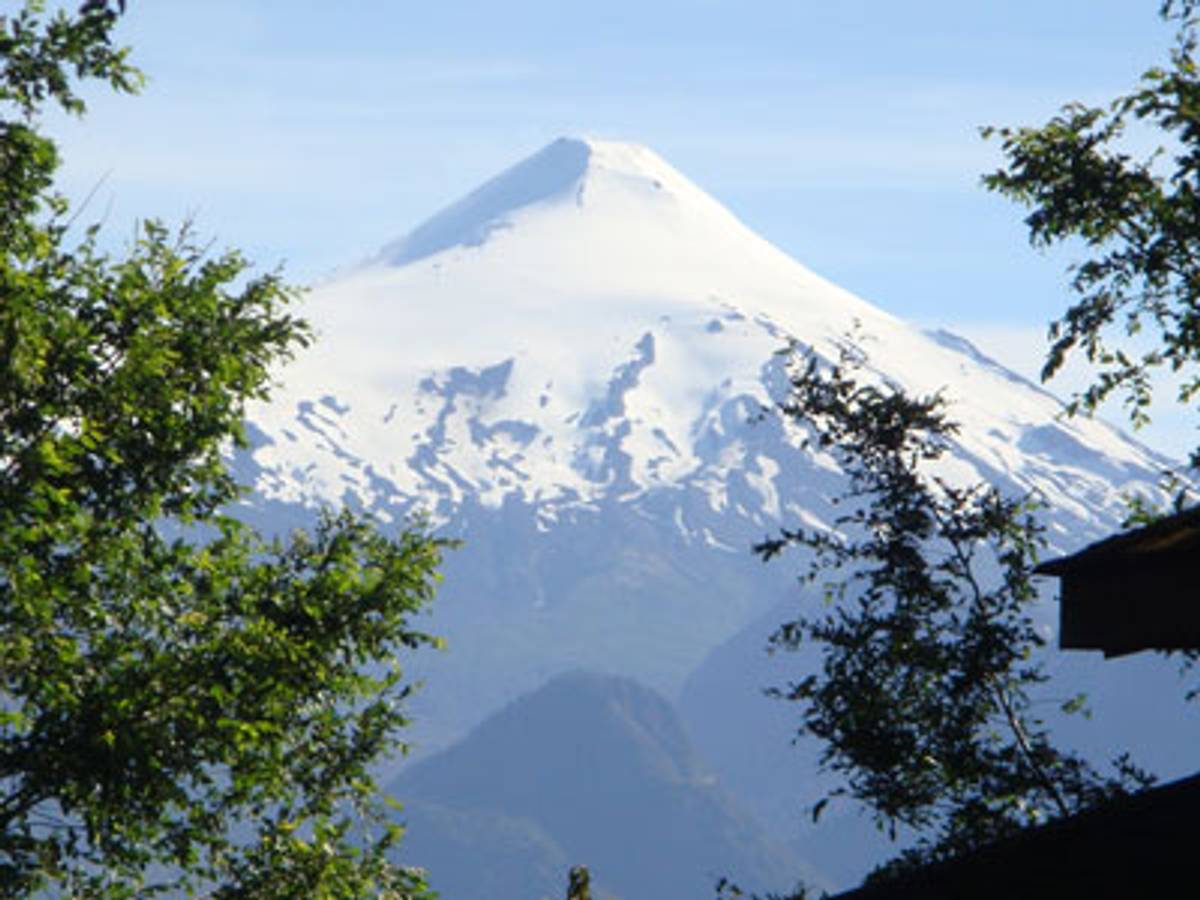
Visualize a huge sloping meadow in the Andean foothills, and then picture a dozen cabins with movable views of Volcán Villarica. Our two-bedroom cabin had a wood-burning stove. Sheep grazed right outside our door and windows. Only the occasional rattle of the truck delivering firewood interrupted the silence of civilization. The internet worked only in the main lodge and with such slowness that we wondered if email detox wasn’t part of the treatment. One wanted to forget about history, to check the baggage of one’s past, to air out one’s identity in the crisp mountain wind.
While my wife and daughters unpacked, I drove downhill and east toward Lake Caburgua—in search of a grocery store. My first stop brought me to a sepulcher of a shop with wilted carrots, potatoes, and apples in woven baskets, no green vegetables, and a large selection of beer; two heavy-eyed men and a girl tended the shop. I eventually found a local supermarket with an adequate selection of provisions and a long meats counter ruled by a butcher clad in a bloody apron, who looked like an executioner. But it wasn’t until stopping at a roadside stall that I actually enjoyed shopping for produce in the Chilean countryside. It was a shack covered with a tin roof and lit by the light pouring in through the slits in the three walls. The fruitier, a punchy fellow with a lampshade mustache and permanently blackened fingers, epitomized love of the land. Dealing with him reminded me of buying fruit and vegetables from local farmers while traveling across the south of Russia in the summer of 1986—my last Soviet summer.
I asked the squinting fruitier, in my Italianate, almost-nonexistent Spanish, what was good, and he answered, “todo,” while spreading his arms as if to embrace all the crates, baskets and barrels crowding his stall. I inquired if the plums were sweet, and the fruitier picked up a yellowish-purplish plum, wiped it on his apron and handed it to me. In dire violation of everything I’d been told at a travel clinic at Beth Israel Hospital—and against commonsense—I took the succulent plum from the Chilean man’s hands and bit into in, a sensuous if unclean experience. I let the fruitier choose the fruit and berries for me, and while he placed them in cone-shaped paper sacks, I picked green vegetables. The last item to negotiate was a particularly gorgeous pumpkin, from which the fruitier, manipulating a cleaver with the grace of a magician, cut about a quarter and wrapped in a newspaper spread.
For some reason, my mood brightened after the good commerce with the Chilean fruitier. When I returned to our cabin, I found my wife standing on the porch and chatting with the resort’s proprietors, Cristian and Graciela. A smiley man of few words, Cristian outwardly resembled a featherweight boxer. When he spoke, he aimed his gaze not at the eyes of his interlocutor but a bit past them, and his gaze felt like a bullet entering one’s temple. Cristian was reticent about discussing his past. We somehow surmised that he had lived abroad, in Italy. There were many Chileans who went abroad during the Pinochet years and later returned. And the silence about exile was part of a greater national silence about the past, about the junta years, about political repression coupled with economic advancement. One could visit the Museum of Memory in Santiago and be shocked and dismayed. It was much harder to learn an uncurated version of a not-so-recent past from the ordinary Chileans. Cristian, the resort proprietor, eventually told me that he had founded Mirador Los Volcanes in 2006 and that he had studied electrical engineering. During the Pinochet years, he had been a student in nearby Valdivia, and he went to Italy for postgraduate training.
Not that we tried to conceal our Jewishness while traveling in Chile, but we didn’t advertise it, either. These days, when I go back to Russia, where I had drunk my cup of anti-Semitic mead, I’m very open about Jewishness. But here in Chile? Why stick out and invite reactions, especially in rural areas? Some time ago at Boston College, where I teach, we ran a program about Jewish literature. One talk was about Jewish writers in Latin and South America. During a lively Q&A a period, a woman with a pale face and raven-black hair got up and described growing up in Chile as a child of Jewish refugees and having to endure at elementary school, day in and day out, the chanting of “¿Quién mató a Jesús?” with the predictable response blaming Jews for the killing. The episode stuck with me, and prior to the trip to Chile, I had resolved not to be overexplicit. Yet coming across as nondescript Americans was easier said than done. When Karen gently asked the proprietress not to bring us ham with the breakfast tray, Graciela wondered if we were vegetarians.
“We don’t eat pork,” I explained. And then I added a Spanish phrase, “Soy Judío.”
Cristian nodded with compassion, as though in his eyes we were fellow victims of tyranny, and turkey replaced ham as our breakfast meat.
In the evening of our second day near Pucón, my daughter Mira and I went fishing at Río Liucura. We parked near a bridge and fished, using trout worms I’d dug up at the proprietors’ kitchen garden. We were casting upstream and letting the water carry the hook and worm downstream into pools of water. We had many bites but only landed three smallish rainbow trout. Mira amazed me by catching a trout all by herself; she patiently played the fish until it was exhausted and then landed it, stylishly. Mira said she was being my “special fishing friend.” For some reason fishing for trout near a bridge in a mountain river in a Spanish-speaking country made me think of the section in Hemingway’s And the Sun Also Rises, where Jack, the narrator, takes his friend Bill fishing. Jack digs up worms and uses them for bait, but his friend prefers fly-fishing. Mira and I were fishing at the sunset hour, and I was thinking of how, despite the fishing affinity, I could never identify with Jack, Hemingway’s alter ego. Instead, I’ve always identified with Cohn, the New York Jew who becomes Princeton’s middleweight champion not because he loves to box but because he needs the victories to triumph over his Anglo-Saxon detractors. Cohn does not go trout-fishing with Jack; he has bigger fish to fly. A raft of associations with Hemingway and Spain carried me downstream to the Spanish Civil War and the International Brigades. Already after having written and published And the Sun Also Rises, Hemingway met many Jews fighting in Spain on the Republican side. They were Jews from the Soviet Union, France, Britain, the United States, I was thinking as trout jumped after mosquitoes. But some subcuticular bigotry remained, and it continued to poison certain pages of the writer’s life. This was, perhaps, akin to something that stays even after one has washed the dirt and blood from under one’s fingernails. The faint anti-Jewish prejudice lived on even in such progressives as Hemingway, and there was no denying it. I was thinking: The day will come when my children will read Hemingway in college, and they will have to contend with the author’s prejudice not only against the fictional Jew Cohn but also against real-life Jews, like Gertrude Stein. Once again, these were things a young Jew has to learn by herself; they cannot be taught or explained, even by parents.
In the meantime, New Year’s Eve approached, and Cristian invited us to a celebration to take place at the main lodge. They would be slaughtering a cordero, he said, so there would be meat for us to eat in addition to a pork loin they would also be roasting. On the chilly and foggy morning of December 30th, my younger daughter Tatiana requested to observe the killing of the chosen lamb.
“I hate these sheep,” Tatiana announced. “They are disgusting and they always try to steal food from our porch.”
We followed Juanito, a local young man who was employed at the resort as a shepherd and jack of all trades. He roped a five-month-old lamb, which looked the size of a grown sheep, and led it to the shed attached to the main lodge and owners’ house. Juanito was assisted by a young woman, who cleaned the cabins and whom my daughters believed to be his girlfriend. Juanito performed his task with the simplicity and bluntness of a peasant, and without false sentimentality, cruelty or machismo. He sharpened his long knife, and he and his girlfriend tied the front and hind legs of the lamb and placed it on the block where dozens of the lamb’s kin had met their death. It was then that my Litvak great-grandfather Rabbi Chaim-Wolf Breydo (Broyde) appeared before me, the last one in our lineage of stern Misnageddic rabbis, he who was murdered in his home in 1941. My great-grandfather appeared before me and demanded that I explain to Tatiana what shechita requires.
“One needs to say a special prayer before slaughtering an animal to eat,” I whispered to my daughter.
“Like an apology?” Tatiana asked.
“Yes, sort of like an apology and a blessing,” I answered. “We also need to have a sharp very smooth knife, in order to cut very precisely and quickly across the animal’s neck.”
Tatiana listened closely, furrowing her brow.
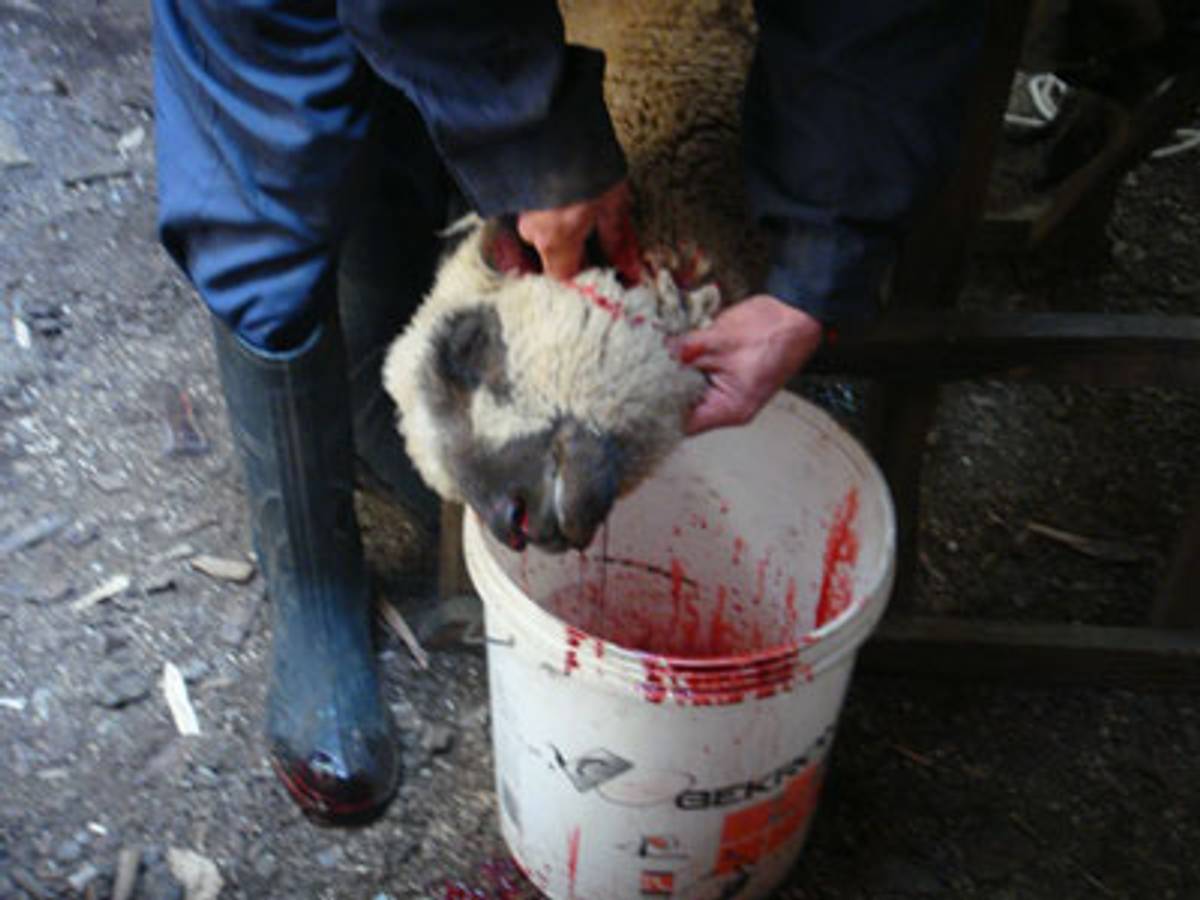
Juanito’s girlfriend held down the lamb’s back and hind legs. Juanito rolled the lamb onto the back and side and lowered its head. Like a knife-thrower, he swiftly placed the knife in his right hand, then held the lamb around the ear with his left hand and nimbly put the blade through its neck. Tatiana and I watched the knife enter the throat and cut the carotid artery. The lamb moaned something melodic and rolled his eyes; scarlet blood poured out into a white plastic bucket of the sort we use when we go fishing on Cape Cod.
It rained all afternoon in the foothills of the Andes as the lamb slowly roasted on a spit. Christian and Graciela served a simple menu to go with the meats—sliced tomatoes, lettuce, choclo (Andean corn), boiled potatoes. Pisco sour was passed around as an aperitif; excellent Chilean wines accompanied the meal, and bubbly and cake crowned the festivities. It was a South American crowd—Chileans, Colombians, Argentinians, Brazilians. Politics never once came up except when we were comparing travel notes with an Argentinian family sitting next to us. There was a slender wife, two kids the age of our girls, and a jovial husband who looked a lot like Diego Rivera. I mentioned Santiago’s Museum of Memory and Human Rights, and Karen described how I got sick after visiting it. The Argentinian man, who had driven his family to Pucón for a vacation, said, “Yes, they had it bad in Chile.”
It had cleared by the end of Jan. 1, 2015, temperatures soaring to what we had been expecting of a Chilean summer. Without the obstructing clouds, the clarity of the view was such that we could see a fiery halo over the white cap of Vólcan Villarica. Like a fine reddish fur on the snout of a giant wild animal, the halo reminded the viewers that the volcano was active, and in fact it would erupt again only two months after our visit, causing an evacuation of local residents.
It was our last day in Araucanía, and I was still searching for signs of Jewish life. Perhaps there wasn’t any? I mused. A lakefront honeycomb of cafés, boutiques, and guesthouses, Pucón itself was no Montreux, but it gave its visitors a relentlessly beautiful view of the volcano. After wandering the lakefront and having drinks at what was recommended to us as Pucón’s only European hotel, after tasting mote con huesillo from a street vendor, we got back into our tired Citroen and headed back to our cabin for a farewell barbecue. On the main road, already on Pucón’s outskirts, my daughters spotted a wooden sign with a menorah and a wooden post with eight branches and electrical lights on top. We stopped and read the sign: Jewish Center Chabad House Pucon Chile (missing the accent in Pucón) Camino Internacional 1415 Tel. 442335. It was Saturday afternoon and the gates were locked.
Hotel La Clara
Not only the Chilean expatriates we had interviewed prior to the trip, but also every Chilean we met during our travels spoke with fondness and nostalgia about the area of Valparaíso-Viña del Mar on the Pacific coast. Chileans related to the resorts in the country’s Pacific North in a way that reminded me of the Soviet Jews of my generation (and also our parents) waxing sentimental about the Baltics—the Estonian Pärnu, the Latvian Jūrmala—where we used to go in order to escape, just temporarily, from the oppressive reality of Soviet Russia. We have met Chileans who vacationed in Viña as children, who were married in the nearby La Serena, who spent their honeymoon in Viña’s historic Hotel Oceanic.
On the way from the Santiago airport to Viña del Mar, we traversed the sloping emerald vineyards of the Casablanca Valley. We had been expecting, finally, to see a thing of beauty, a seaside resort that binds the visitor’s gaze. Viña immediately struck us as an overcrowded, seamy city bustling with cheap commerce and hundreds of small buses loading and unloading passengers at street corners. Now and then, elegant colonial-style buildings showed their façades through chinks of urban squalor and high-rise apartment buildings. There were also signs of real poverty, old men eating on dirty steps, women begging for alms. And there were stray dogs, packs of quick-witted stray dogs roaming the streets of Viña del Mar.
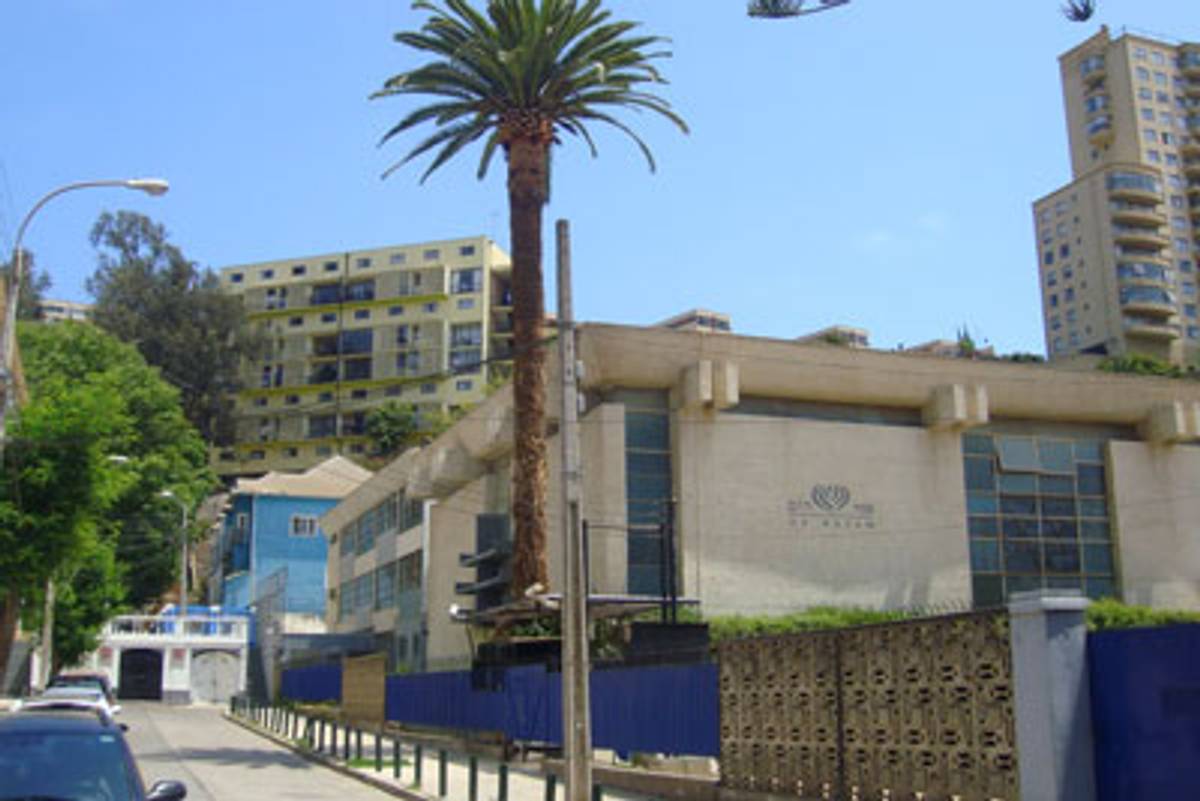
We were staying in a small hotel called La Clara (I’ve altered the name). Usually, I’m a discerning travel planner of the sort who carefully researches the guides and reviews and even looks at satellite photos, but judgment had failed me. La Clara Hotel was mostly a marketing fiddle. On internet sites, it was being advertised as Viña’s top boutique hotel, elegant, renovated, a short walk to the oceanfront and historic attractions. Located on a dead-end street off a busy thoroughfare, La Clara was a refurbished Victorian mansion, partly renovated, partly repainted over many tiers of lizard paint. Windows were missing locks and screens, and tiles had toothy broken corners. Cacti and succulents grew downward from stone walls outside the windows, and a keyhole view of the Pacific revealed itself from one corner of our living room. And as irony would have it, next door to us, also in a Victorian-era mansion, was a boutique retirement home called Primavera, while two doors down there was a complex with a synagogue, Jewish school, and Jewish community center.)
The ocean was not a short stroll but a robust half-hour walk from our hotel. My first impressions of Viña were distinctly mixed; it brought to mind what Chekhov had said about Yalta during his first visit there (I paraphrase freely): a mix of something beautiful and something vapid, the Occident and the Orient, grunginess and refinement, elegance and squalor. Perhaps only the section of the Viña waterfront gave one a taste of the city’s depleted charm. One would have a drink at the bar in Hotel Cap Ducal, a small permanently moored ocean liner painted white and accented in red and blue; one would stop in for lunch in the locally famous Chez Gerard with its solicitous waiters and festive atmosphere of a summer evening on Nice’s Promenade des Anglais, and then would finally begin to imagine what feelings overcame the Jewish immigrants from Europe when they reached these shores. Vendors were offering cheap trinkets, the usual sacks of nuts and dry fruits and sugared candy; children and adults on tricycles were zipping up and down the promenade and around the fountain in a dusty public garden. Painted clowns stood frozen, unblinking; local artists offered maritime landscapes. Roma women in long motley skirts accosted tourists, offering to read their palms or simply asking for money.
“I have a weak spot for Gypsies,” I told Karen and the girls. “ ‘The Germans killed us in the same gas chambers,’ my father used to say to me when I was a kid back in Russia.’”
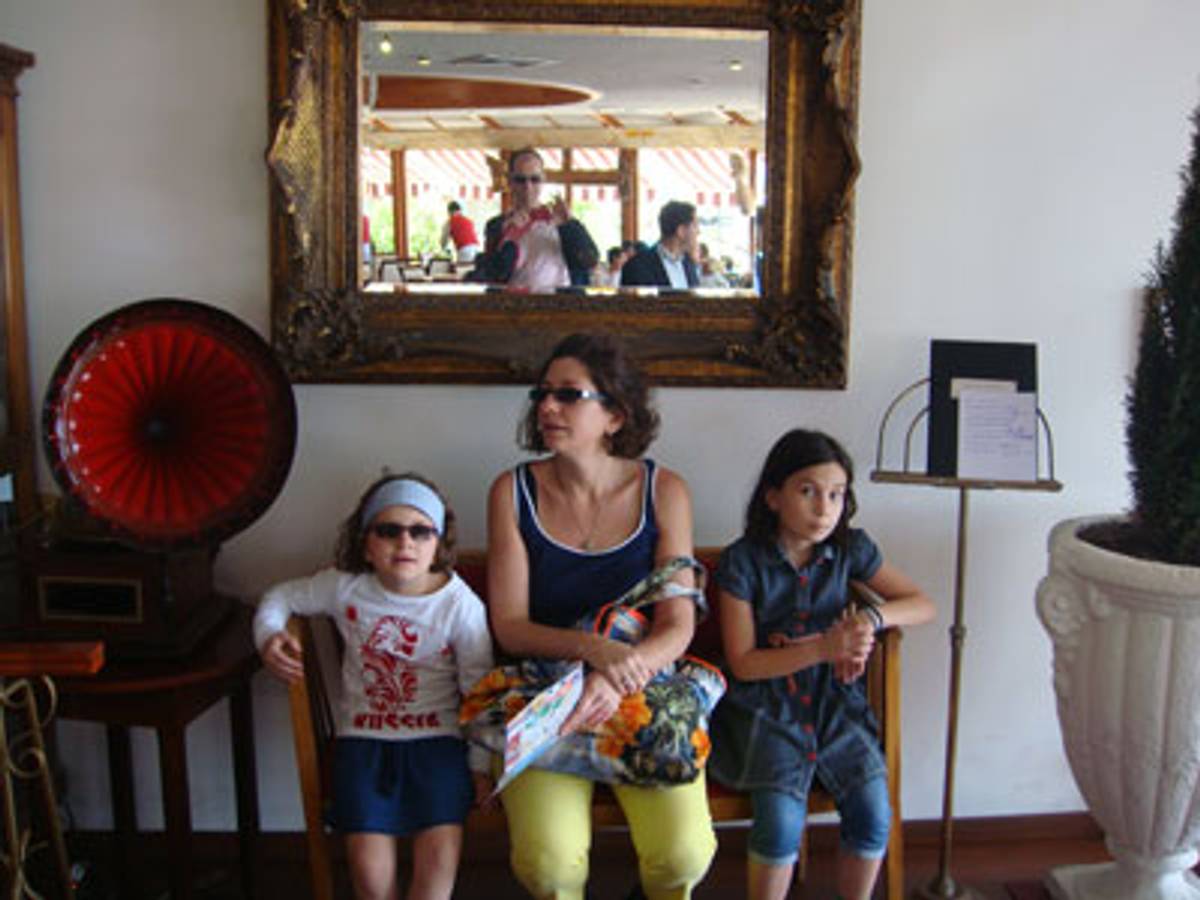
Our first full day in Viña was a sequence of small, pleasant adventures. It was very foggy in the morning, almost as foggy as it is in our beloved Chatham on Cape Cod on many mornings, and the fog was supposed to burn off yet never did. We visited a swimming beach, Las Salinas, but there were jellyfish and the water was unbearably cold. Later we wandered into the futuristic Sheraton Miramar and checked the internet. Knowing from my posts that we were heading to Viña del Mar, my colleague Jim Kates, a Boston-based poet and translator, posted a comment about a bartender by the name of Julio César who used to work at landmark Boston restaurants. Jim advised that the legendary bartender was now employed at Sheraton Miramar and made “the best” pisco sour in town, and we happened to be on the Sheraton’s waterfront terrace ordering coffee when I read the post. Julio César, whom we sought out at the hotel’s lavish bar, was a suntanned and very friendly man in his 50s whose figure and posture bore a resemblance to his renowned Mexican namesake, the boxing champion. I hesitated to ask when and under what circumstances our Julio César left Chile, but it was apparent from what he told us that he had lived in Boston for a long time. To Julio César we owed two things that made our time in Viña more enjoyable: He sent us to a wonderful Italian restaurant run by his sister and brother-in-law, and he also made sure that we were treated well at the Sheraton Miramar. We rode back to our hotel in a Sheraton minivan, chauffeured by a former Chilean marine, a man with a barrel chest and slicing eyes. He spoke excellent English and told us he used to be stationed at the Chilean embassy in Washington.
Our hotel had arranged a guided tour of Valparaíso for our last full day in Chile. The guide and driver were supposed to pick us up in the morning but were running late. Instead of waiting in the lobby, Mira, Tatiana, and I went to visit the Jewish center down the street from our hotel. The first two attempts had failed. A guard told us he couldn’t let us in due to “security considerations.” I gave him my Boston College business card, explained that I worked in Jewish Studies and “just wanted to see the shul.” The guard promised to give my card to the “director” and told us to come by later. On the next day, a different guard refused to let us in because we “weren’t on the list”—whatever the mysterious list referred to. I was reminded of being in Vienna, a recently arrived Soviet refugee, and of being refused entrance to a synagogue by Austrian policemen standing guard. But that was Vienna in 1987, with real terrorist threats hanging in the air, and this was Viña del Mar in 2015. The third time, holding down a knitted Israeli kipa so it wouldn’t get blown off my head, I attempted to reason with the guard. He acquiesced and allowed us to walk around the inner courtyard. We looked at the outside of Colegio Hebreo “Dr. Jaim Weitzman” and then entered the synagogue.
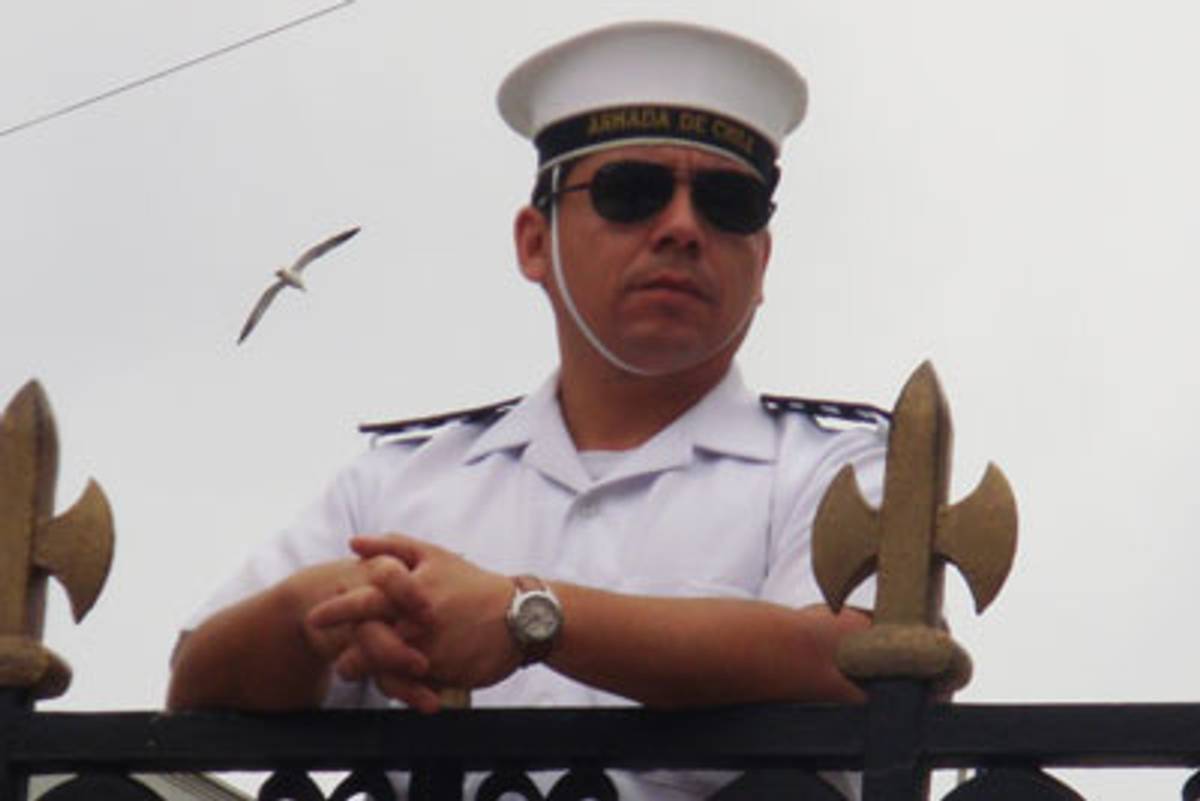
Built in 1965, the synagogue was called Or Hayam, or Light of the Sea. On the plaque commemorating the founding of the synagogue and listing the men who were then leaders of Comunidad Israelita de Valparaíso, Germanic last names predominated, and Jewish-Russian or Jewish-Polish last names were enmeshed with Sephardic-sounding ones. The founders’ first names included two Borises, a David, and an Israel, a Claus, a Günther, two Kurts, a Juan, a Luis, and two Josés.
Valparaíso—city of staircases, funiculars, funky cafes, fading beauty, foreign cargo boats, Chilean navy, murals large and small, murals morphing into graffiti and the other way around. Its vibe reminded me of seaside cities in the south of Europe, especially Marseille.
The name of our guide was Sebastian. A tired olive-skinned man in his mid-20s dressed in black and air-force blue, his face radiating martyrdom, Sebastian resembled his saintly namesake tied to a tree and pierced by Emperor Diocletian’s arrows, a walking incarnation of inaction, submission, placidness. To him, our family probably epitomized impatient, self-rewarding, self-contented Americans. That is, until I told him I grew up in the former Soviet Union and left at the age of 20.
We had finished our walking tour and were standing in the port of Valparaíso. Rows of smaller pleasure and fishing vessels lined the harbor. Moored to veiny strips, cargo boats were unloading and taking in containers of merchandise. Far ahead, just below the horizon, a Chilean battleship bathed in milky fog. Here, in Valparaíso, the home port of the undefeated Chilean navy and Pinochet’s birthplace, the coup of 1973 raised its head. We were waiting for a taxi, which wasn’t coming, and the girls were growing weary.
I finally asked Sebastian what I’d wanted to ask him the whole day but held back: “How do you feel about the legacy of Pinochet’s rule?”
“Chileans we’ve met have been reluctant to engage on the subject,” I explained. “This really interests me as someone who grew up under a repressive regime.”
“You’re right, this isn’t something people talk about,” Sebastian replied. He spoke excellent English.
“Could you please elaborate?” I asked.
“It was politically a terrible time,” Sebastian said. “But people of my grandparents’ generation would say they benefited economically and socially from Pinochet’s regime.” Sebastian grew silent.
Then, in what seemed like a non sequitur but really wasn’t, he added, very quietly, “The CIA did a lot of damage here, you know.”
“Yes, I know, and so did the KGB,” I flared up.
A Chilean navy man standing nearby looked at us with strained apprehension. Sebastian didn’t say anything, turning his doleful gaze to the busted lips of granite paving stones.
For some reason, the knowledge that Chile was a slaughtered lamb on the altar of the Cold War brought no relief. A few years prior to the Chile trip, my father and I had stopped in Madrid; we were on our way to Israel to speak at a conference on multilingual Jewish writers. In the evening, strolling blissfully in the Salamanca neighborhood, we chanced upon a Neo-Falangist rally not far from Plaza de Colón. Lads and ladies in leather and metal held torches and chanted “Justicia, Libertad, Espagna,” and from their mouths, these slogans came out like swear words. After I described the incident in a short essay published in Snob, a popular Moscow magazine-cum-chatroom, I got a call from my friend P.B., a Jewish-Russian author and a fellow émigré.
“I liked your piece,” said P.B. “But you know that the Soviet secret police was behind very many members of the International Brigades?”
“So is this knowledge supposed to make me feel better that Franco won and the Republicans lost?” I remember asking.
“If the Spanish Civil War were to happen again, I would fight against Franco. Like the other Jews did,” I told my ex-Soviet friend. He didn’t say anything in response.
Standing with my wife and daughters in the port of Valparaíso, I wanted to say to Sebastian that I couldn’t assume the legacy of the US involvement in Chile even as this legacy was made my own—by default. As a Jew, an ex-Soviet, an American, I couldn’t justify violence committed in the name of stopping the spread of Marxism in South America. Nor could I, despite the Soviet support of Allende’s regime, imagine myself among Pinochet’s passive endorsers. Our taxi finally arrived, and we said a hasty goodbye to Sebastian and drove off in the direction of Viña del Mar and sunset.
Pisco at Noon
We had left Hotel La Clara, having arranged to spend our last Viña morning at the Sheraton by the sea. We lazed in chaise lounges, soaked in hot tubs with views of the Pacific. Below the terrace, violent waves of the Pacific slammed against serrated rocks. Pelicans sat on granite ledges, feeding their hungry offspring. Once again I imagined German and Austrian Jews who had reached these shores in the late 1930s. Here one felt so far from Europe and from cursed questions of politics, allegiance, and identity.
Pisco, Chile’s national liquor, is a variety of brandy, tasting a bit like the Italian grappa but with more body, closer to cognac. Chileans whip it up with lime and sugar or syrup and often serve it in champagne glasses; the resulting foamy concoction is called pisco sour. Back in Araucanía, I had taken to drinking pisco neat from a shot glass or snifter, and I asked for a pisco during our farewell lunch at the hotel’s main dining room. As my wife ordered in Spanish and negotiated our younger daughter’s food allergies, a man about my age, hazel-eyed, thread-lipped, with neatly groomed salt-and-pepper hair, came up to us and offered help, speaking English with great confidence. He must have noticed my daughter’s backpack with letters of the Hebrew alphabet. The Chilean man was, it turned out, a cantor from Santiago, a Sephardic Jew, and he had come to Viña for a few days with his daughter. He pointed to a high-school age girl in a long skirt, who waved from a nearby table.
“How do you like Chile?” the cantor asked.
“We loved the natural beauty,” Karen replied.
Undiluted liquor, consumed on an empty stomach, had untied my tongue. “I grew up hearing a lot about Chile,” I said. “But this trip wasn’t what I expected.”
“What do you mean?” the cantor asked.
“I have mixed feelings about failed socialist reforms corrected by years of junta,” I blurted out. “Where is the Chilean miracle, anyway?” I added, challenge in my voice.
“It’s here, look around,” the cantor spread his arms. Behind his back, through the glass windows of the Sheraton dining room, outlines of ships and contours of Valparaíso shimmered in the fog.
I should have stopped right there, but I didn’t. I went on to tell the cantor how they almost didn’t let us into the local Jewish community center.
“Well, you see, there are real security concerns here,” said the cantor. “We have neo-Nazis, and also half a million Palestinians living in Chile. Frequent threats are made to the Jewish community.”
“Why don’t you leave?” I asked. “Didn’t many Chilean Jews leave in the early 1970s?”
“Yes, and some came back after things settled down,” the cantor said, euphemistically referring to the years after the coup of 1973.
“This is hard for me to relate to, quite honestly,” I said to the cantor. “I grew up in the Soviet Union. We were refuseniks.”
“There are still some 15,000 Jews in Chile,” the cantor answered. “Mainly in Santiago but also in this area and smaller communities. We have a good life here.”
Our food arrived, we thanked the cantor, and an hour later we were already traveling to the airport in a black shiny minivan, driven by an agile gentleman with a brush of silver mustache and black raindrop sunglasses.
As we waited to pass security, the cozy Dostoyevskian “and yet” kept rolling in my head. I meant it when I told the cantor that I had mixed feelings about the trip. And yet, I still felt a warm something for Chile, something akin to the youthful illusions one could never fully abandon. In this world, a Jew triangulates among the absolutist tenets of Judaic ethics and the relativist imperatives of Jewish survival. Such is our Jewish predicament, and such is the bundle of contradictions you have yet to discover.
This is, more or less, what I would have liked to tell my daughters as we waited to board our flight back home. Instead, I took them to a souvenir shop decorated with Andean artifacts. There, from a barrel full of polished rocks, we filled a small canvas sack with Chilean gemstones, each the size of a large cherry or a prune. The gems are now sitting in a ceramic dish on our mantelpiece. As I type these lines on a rainy day on the eve of Pesach, I’m looking at the Chilean gemstones, veiny blue lapis lazuli, red bleeding agate, silver purplish dumortierite, and rusty-orange opal. I think of Chile as my lips whisper a Jewish-Russian incantation: lazurite for truth, agate for courage, dumortierite for patience, and opal for memory.
***
You can help support Tablet’s unique brand of Jewish journalism. Click here to donate today.
Maxim D. Shrayer is a bilingual author and a professor at Boston College. He was born in Moscow and emigrated in 1987. His recent books include A Russian Immigrant: Three Novellas and Immigrant Baggage, a memoir. Shrayer’s new collection of poetry, Kinship, will be published in April 2024.